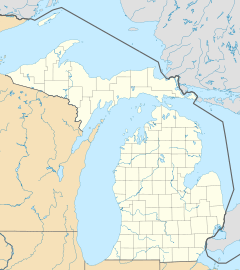Jamestown Charter Township, Michigan facts for kids
Quick facts for kids
Jamestown Township, Michigan
|
|
|---|---|
|
Charter township
|
|
| Jamestown Charter Township | |

Location within Ottawa County
|
|
| Country | United States |
| State | Michigan |
| County | Ottawa |
| Established | 1849 |
| Area | |
| • Total | 35.48 sq mi (91.89 km2) |
| • Land | 35.38 sq mi (91.63 km2) |
| • Water | 0.10 sq mi (0.26 km2) |
| Elevation | 722 ft (220 m) |
| Population
(2020)
|
|
| • Total | 9,630 |
| • Density | 272.2/sq mi (105.1/km2) |
| Time zone | EST |
| ZIP code(s) |
49315 (Byron Center)
49323 (Dorr) 49418 (Grandville) 49426 (Hudsonville) 49427 (Jamestown) 49464 (Zeeland) |
| Area code(s) | 616 |
| FIPS code | 26-41520 |
| GNIS feature ID | 1626537 |
Jamestown Charter Township is a special kind of township located in Ottawa County, Michigan. In 2020, about 9,630 people lived there. It's a place with a rich history and a growing community.
Contents
Exploring Jamestown's Communities
Jamestown Township is home to a few smaller areas, each with its own story. These include:
- Forest Grove: This community is located very close to the main area of Jamestown.
- Gitchel: This area was named after S.L. Gitchel, an early settler. It even had its own post office for a while, from 1886 to 1902.
- Jamestown: This is the main, unincorporated community within the township.
The Early Days of Jamestown Township
Interest in settling Jamestown Township began as nearby towns like Grandville and Holland were growing. The land was covered in thick forests. In 1831, the area was surveyed and mapped.
First Settlers and Early Life
The very first settlers in Jamestown Township were James Cronkright and his wife. They arrived in 1843 and built a small house. Their closest neighbors were miles away, and there were no roads. Wild animals like bears and wolves were common, but deer provided food.
S.L. Gitchel, another early settler, arrived in 1845. He became known for building small bridges and special "corduroy roads" made from logs. More families soon followed, some from the east, and others, called Hollanders, came from the west. Later, German families also moved into the area from the south.
Forming the Township Government
Before 1849, Jamestown and Georgetown Township were governed together. All taxes were paid in a place called Jenison.
To become a separate township, Jamestown needed at least twelve voters. By 1849, there were enough people, and they decided to form their own township. A meeting was held at James Cronkright Jr.'s home. Twelve men attended, and they all took on different roles in the new government.
Since one-third of the men present were named James, they decided to name the new township Jamestown. Six other men who lived in the township couldn't attend, possibly because four of them didn't speak English yet.
Early Records and Schools
The first tax roll in 1849 listed fifteen residents and seventeen pieces of land. These lands were spread across only 9 of the township's 36 sections.
The first town meetings were held at the Cronkright home. Later, they moved to the first log schoolhouse in 1851. By 1853, a second log schoolhouse was built in Jamestown Center. Another log school, the Forest Grove school, was also built in 1853. These schools were very important for educating the children of the township for many years.
Much of this early history comes from a book called "The Early History of Jamestown" by Mrs. Pauline Hall Gitchel.
Jamestown's Geography
Jamestown Township covers a total area of about 35.6 square miles (91.89 square kilometers). Most of this area is land, with only a very small part being water.
Who Lives in Jamestown? (Demographics)
According to the 2020 Census, 9,630 people live in Jamestown Township. There are about 2,695 households. The population density is about 272 people per square mile.
Diversity in Jamestown
Most people in Jamestown Township are White. There are also smaller groups of African American, Native American, and Asian residents. About 1.13% of the population is Hispanic or Latino.
Families and Age Groups
Many households in Jamestown are families. About 49.9% of households have children under 18 living there. Most families are married couples living together.
The average household has about 3.37 people. The median age in the township is 31 years old. This means half the people are younger than 31, and half are older. About 34.9% of the population is under 18 years old.
Income and Economy
The median income for a household in Jamestown Township was about $68,689. For families, the median income was around $71,438. Only a small number of families and people live below the poverty line.
Places to Visit in Jamestown
Cemeteries
Jamestown Township has several cemeteries, which are historic resting places. These include:
- Zutphen Cemetery
- Star Cemetery
- Forest Grove Cemetery
- Jamestown Cemetery
Lakes
There is one notable lake in the township:
- Mud Lake
Education in Jamestown Township
Most of Jamestown Township is part of the Hudsonville Public School District. A smaller part of the township is served by the Grandville Public Schools.
The local library, called Patmos Library, is located at 2445 Riley Street in Jamestown.
See also
 In Spanish: Municipio de Jamestown (Míchigan) para niños
In Spanish: Municipio de Jamestown (Míchigan) para niños



